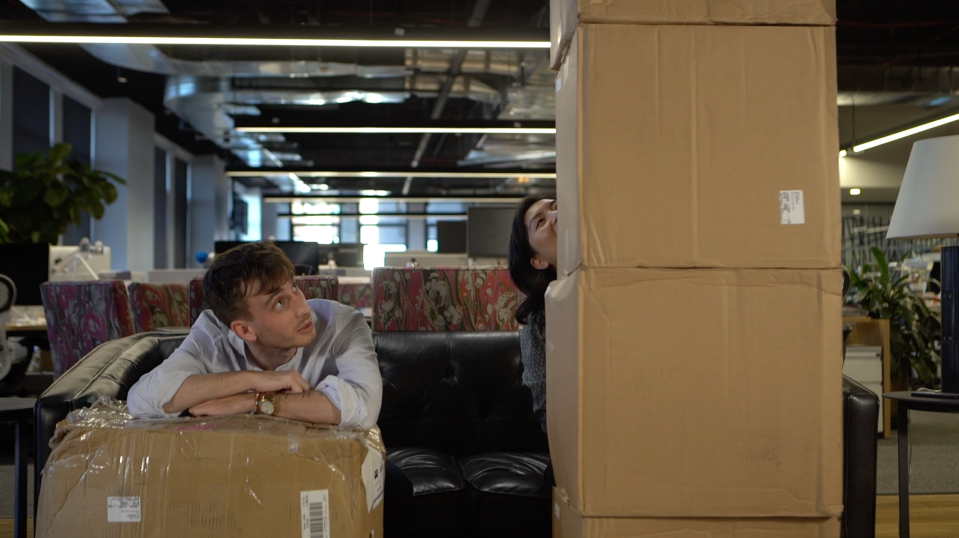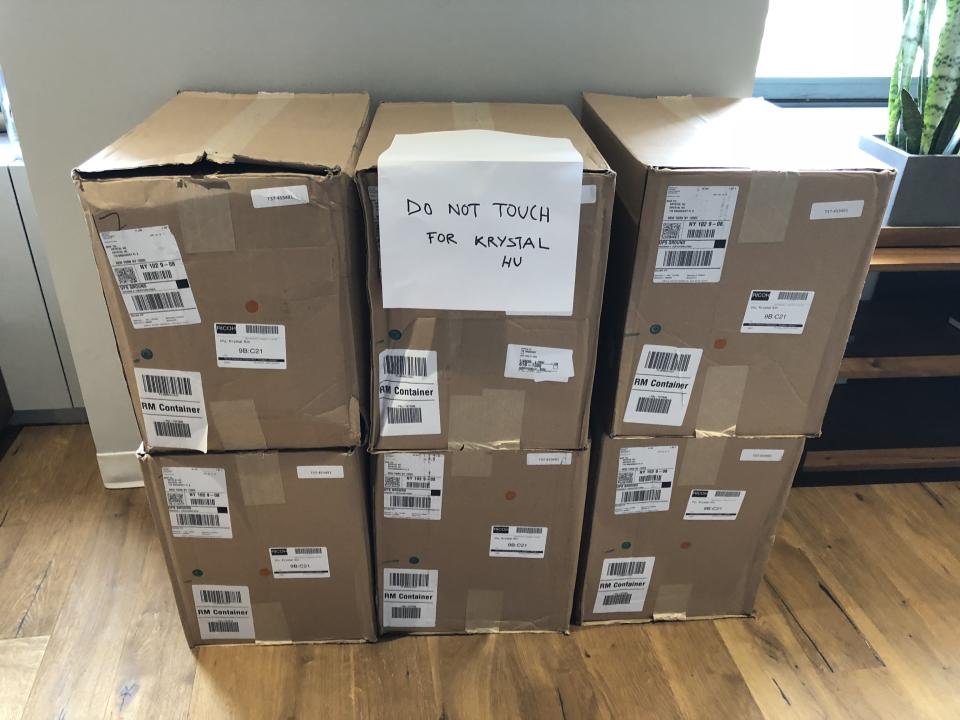We entered the multi-million dollar business behind your Amazon returns
If you’re one of the over 1 million Amazon Prime members, chances are you’ve taken advantage of its free return policy. Known as a customer-centric company, Amazon (AMZN) allows customers to return orders within 30 days after they receive it. During the holiday season, it’s even more generous — Items shipped by Amazon in November and December may be returned until January 31 of the following year for a full refund.
In most cases, Amazon can’t sell the products back to customers. It’s not uncommon for online retailers to see 30% of all products people ordered online returned, as compared to 8.89% in brick-and-mortar stores. Clothing return rates can be close to 40%.
Have you ever wondered where your Amazon returns go? Yahoo Finance found out and tried to get in on the action.

Big business in returns
Turns out there is a multi-million dollar business behind mounting Amazon returns. Some online marketplaces allow you to buy Amazon returns online— items are not individually packaged but are bundled in huge pallets based on categories. Warehouse liquidation has always been how retailers remove inventory. As e-commerce evolves, this liquidation process has also moved online. Now websites like Liquidation.com and Direct Liquidation sell merchandise from major retailers, including Walmart and Amazon.
On those websites, shopping for liquidated returns is similar to shopping for daily items from Amazon— but with a huge discount and orders come in big pallets. You can choose the product category, but you can’t decide what products are in a pallet. Liquidation platforms buy returns from Amazon and repackage things. The longer the retailer’s return period is, the worse the quality the returns may be. Amazon shoppers can return goods within 30 days while customers at Walmart.com can only do so within 14 days.
“So if you use something for seven days, it has fewer chances of having more wear than if you use it for 30,” Diego Medina, director of Direct Liquidation Sales, told Yahoo Finance.

Platforms like Direct Liquidation do the math and decide what products should be put in the same package and how much they cost. “What determines that is the data that we have collected over the years, whether we’re going to profit more or not,” Medina said, adding that it depends on how fast they want to get rid of the inventory, they can set a bid process or fixed price.
People buy returns that are then delivered in pallets or truckloads for business purposes.
“We have people who just buy from us to flip goods. We have people who own their own warehouses. They process every single item on the pallet and then they repalletize to do the sale,” Medina said. “The whole idea here is to increase the profitability for the vendor and at the same time increase the profitability for the reseller.”
Buying and receiving the pallet
My co-worker Alec and I decided to buy our own pallet. I chose home appliances, which I thought would be easy to resell. Alec went for electronics.
Shopping on liquidation.com is similar to shopping on Amazon and eBay. Search for the category you want and a list of pallets show up. The website provides a list of what products are in the pallet. But surprises remain — since they’re returns, you have no idea about the condition of each item and if they actually function or not. On the product detail page, it clearly notes, “Items are not inspected and may or may not be functional.”
I ended up getting the pallet which claimed to be worth $1,516 by placing a winning bid of $170, which I believe is still a bargain. When I was about to pay, I was shocked by the shipping cost. Shipping the pallet to our office in New York City cost a whopping $220! The other option that wouldn’t require paying for shipping would be to drive to a warehouse in Indiana to pick the pallet up.
This is classic for online shopping — the shipping ended up costing more than the package itself. Since I already won the bid, I had to pay for the shipping, which ended up costing $390.
The Unboxing

The delivery of my pallet justified the shipping cost. Within a week, I got a call about the delivery — six giant boxes! That’s the ONE pallet I ordered. There were 59 items in the boxes. Alec only paid $80 for shipping since all of his stuff was in one box.
As you can imagine, it took me a while to unbox everything. Some came in really nice and clean condition — The Precision Cooker, the most expensive product in my order, was perfectly sealed. I had exactly the same one at home, which cost me $100. The waffle maker and coffee maker also appeared in good condition. Since everything is from Amazon Liquidation, we were able to find the link for every product on Amazon to learn about their retail price and customers reviews.
From the packages, we also found things got returned for various reasons: some were unopened, some seemed used, while some were just undeliverable packages because of missing addresses. Many packages still had the original Amazon shipping label, but the receivers’ information had been removed.
Of course, not everything was nice and clean. A used white blanket with stains showed up in the boxes, which no one would ever want. And inside a very heavy package was 680 black plastic bags. That was probably why I paid so much for shipping.
But nothing was weirder than the tiller from Alec’s package — an obviously used one with fresh dirt and leaves from someone’s backyard. We had to wonder if the person who returned it to Amazon ever received a full refund. Fraud and abuse returns are estimated to cost $22.8 billion for the U.S. retail industry, according to National Retail Federation. The most expensive item in the pallet was a cryptocurrency mining machine, which we both failed to recognize in the beginning. Maybe someone bought it during the bitcoin craze last year and returned it when it lost nearly two-thirds of its value from its peak since this April.
Trying to resell

Since people buy Amazon returns mostly do so to resell items rather than use it for themselves, we wanted to test if it’s an easy and feasible business. So I picked a few things that looked brand new and put them on eBay. The cooker and robot vacuum were easy sales. Partly because I offered a really good deal — eBay’s algorithm told me to put the starting price of the cooker at $25, which is only a quarter of its retail price on Amazon. Someone won the bid at $56.
It came to our surprise that someone bought Alec’s tiller — for $15. Then we realized getting things sold on eBay wasn’t the problem — it was paying for the shipping. Alec needed to cover the shipping cost of the tiller to North Carolina, which will cost at least $20.
Learning from Alec’s mistake with the tiller sale, I made sure all my listings on eBay required buyers to cover the shipping cost. Of course, not everyone was happy. A buyer complained to me about the $10 shipping cost for the robot vacuum. Low-value items like candles and forks are even harder to sell in this case.
Also, I started to sell things close to home — asking around the office to see if anyone needed a coffee machine or cat litter pads. Then I ran into a moral dilemma as I explained to my colleagues these were Amazon returns. They would ask me if things were really working and whether they’re brand new. Well, honestly, I could not know if any of the items I bought functioned properly. I couldn’t exactly make waffles using the waffle maker to test it out before selling it, either. So I ended up letting one of my co-workers take it home first to try it out. It made delicious waffles and my co-worker’s kids loved it! He paid me $10 (it costs $40 on Amazon).
The Verdict
It’s been a week since I began to sell the returns, and I’m still far away from breaking even. Alec was able to sell more stuff than me but the shipping costs just ate all of his profits.
All in all, it doesn’t seem like an easy business to sell Amazon returns. While it takes a while to turn money around, sellers like us bear the risk of holding the inventory. I think we can probably make the money back, but that may depend on when an eBay buyer wants a fish tank gravel cleaner.
Note: Any money Alec and Krystal made from sold items will go to charity.
Krystal Hu covers technology and economy for Yahoo Finance. Follow her on Twitter.
Read more:
Some Amazon employees say they will make less after the raise
Amazon bought Whole Foods a year ago. Here’s what has changed
Amazon dominates teens’ online shopping habits
Follow Yahoo Finance on Twitter, Facebook, Instagram, Flipboard, LinkedIn, and reddit.
